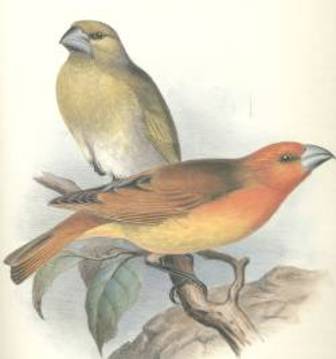Greater koa-finch
The bird was about 10 in long when fully grown. It was the largest known honey-creeper, although its typical weight is unknown. The bird is sexually dimorphic; the male was brilliant scarlet-orange on head, neck, and breast, with lighter orange on its bottom, and olive brown with orange touches on back, wings, and tail; however, the female was brownish olive, and somewhat lighter below. It had a thick black bill which allowed it to break open seed pods that were found in the trees. In historical times, its range was largely confined to the Kona District of the island of Hawaiʻi, although it was observed in the Kīlauea area in 1895 . In Kona, it co-occurred with the closely related Lesser Koa Finch , and the Kona Grosbeak. The Lesser and Greater Koa Finches were once thought by scientists to be the minimum and maximum growth of a single species of Koa Finch.

The Greater koa-finch is classified as Extinct (EX), there is no reasonable doubt that the last individual has died.
the Greater Koa-Finch was found elsewhere. The Kona Grosbeak was closely associated with the naio, or bastard sandalwood, tree (Myoporum sandwicense) growing on relatively recent ‘a‘a lava; its massive beak, hypertrophied jaw muscles, and “thick tongue like a parrots” (Munro journal: 25 Sep 1891) were adaptations for processing the small, very hard fruits of that plant. The beaks of the koa-finches, as their name implies, were adapted for cutting the green pods of the leguminous koa tree (Acacia koa). More
Greater Koa-FinchRhodacanthis palmeri Order PASSERIFORMES – Family FRINGILLIDAE Issue No. 424b Authors: Olson, Storrs L. * Articles * Multimedia * References Courtesy Preview This Introductory article that you are viewing is a courtesy preview of the full life history account of this species. The remaining articles (Distribution, Habitat, Behavior, etc. More
Rhodacanthis palmeri El Greater Koa-Finch (Rhodacanthis palmeri) era una pequeña ave de la familia Fringillidae. Se consideraba que era un ave común al final del siglo XIX, pero los especimenes capturados el año 1896 resultaron ser los últimos. Se conservan unos pocos especimenes en colecciones de Cambridge, Harvard, Londres, New York y Filadelfia. Ver más en Wikipedia.org... More
Greater Koa-finch Rhodacanthis palmeri IUCN Red List history Year Category 2008 Extinct 2004 Extinct 2000 Extinct 1994 Extinct 1988 Extinct Endemic Bird Area Distribution EBA name Hawai'i Country/Territory distribution Country/Territory More
Greater Koa-finch Rhodacanthis palmeri 2009 IUCN Red List Category (as evaluated by BirdLife International - the official Red List Authority for birds for IUCN): Extinct Family/Sub-family Fringillidae Species name author (Rothschild, 1892) Taxonomic source(s) AOU checklist (1998 + supplements), Brooks (2000), Sibley and Monroe (1990, 1993) Summary Rhodacanthis palmeri was endemic to Hawai`i, USA3. More
The Greater Koa-Finch was last seen in 1894 and is considered extinct. The causes for its disappearance are still unknown, as its high-elevation habitat is still relatively intact, and it is above the range of mosquito-borne diseases. More

Family : Fringillidae
Genus : Rhodacanthis
Species : palmeri
Authority : (Rothschild, 1892)

